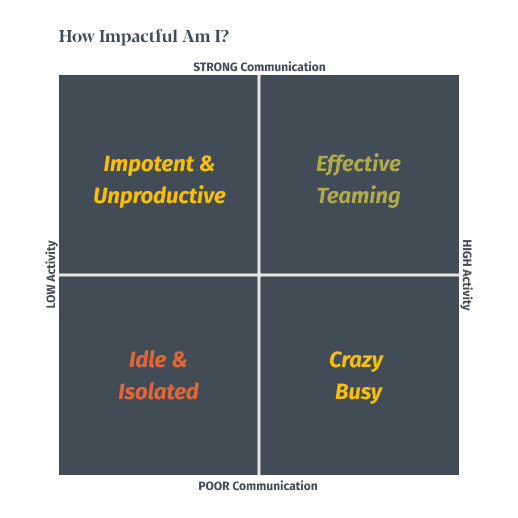
Newsflash! Work is more challenging than it was a year ago. Hardships abound: displacements, demands from home, needs in our own communities. It can feel impossible to manage it all.
So much of my life over the last six months has been reactive. Once I realized this was my reality well into next year, I started asking myself some questions, most notably the following:
Is my work creating the best impact for my team?
As I talked to others I realized that I was not alone in these thoughts. Teams are smoldering. Remote work isn’t exactly easy. The truth is that many people are having a hard time discerning their impact.
Client delivery is THE priority for business; as a result work has become more tactical than strategic.
Deep Magic
But it is generally the harder and cross-functional problems that inspire us. Whether we like to admit it or not, it is the challenging, alchemical, and asymmetric upside projects which we relish deep down.
“[.. M]agic happens when you bring teams together. Specifically cross-functional teams,” explains Zander Lurie, CEO of SurveyMonkey.
“It is the five people sharing a pizza that are .. shipping a new product, launching a new campaign, closing the books,” gushes Lurie. “It is where you have someone from Legal, Finance, Product, and Marketing and bringing those people together.
“Man, I miss getting them together.”
Good leaders know the value of cross-function. Diverse thought added to varied domain expertise create more than the sum of their parts. Focused on deliverable tasks in isolation we have less to measure ourselves against. We can find ourselves off of the path. Would I have wandered this far a year ago?
Even if we somehow cram in the required tasks in the gaps of our new lives: is the work still fulfilling?
Find the Road Back
I can only speak for myself, but if I am feeling listless and unfulfilled it doesn’t correlate to being busy or not. Busy-ness is the wrong metric.
When feeling “off” at work, it helps me to do a simple exercise. This can help me get back to where I need to be. My hope is that this can help you too.
First, I take a blank piece of paper, draw a big plus sign. Label the left line segment with “Low Activity” and the right line segment with “High Activity.” Next, label the top line segment “Strong Communication” and the bottom line segment “Poor Communication.”
It should look something like this:

To begin, I ask myself whether I am active at work or not? That orients me to the left or right side. Next, I ask myself if I am communicating well or not? That helps me orient to the top or bottom.
Answering those two questions will land me in one of the four boxes. If you have a hard time answering those questions try this — which statement seems the most true?
I feel isolated and lacking tasks (lower left)
I feel well connected but lacking tasks (upper left)
I feel isolated but active (bottom right)
I feel well connected and active (upper right)
If I am isolated, communicating will lead to clearer purpose. It might be a reminder from a boss, supporting a teammate’s task, or validation on what work to offload.
If I am idle, searching for new tasks might lead me to a fuller plate, or a breakthrough on efficiency. It also might lead to a great cross-functional project which good leaders value and covet.
Continuous Improvement
The goal here is to find ways to move to that connected and active feeling. But remember! Being chatty and busy isn’t the end-all-be-all, it only helps me to better calibrate.

Already in that top right box? Great! Stay humble as there is always room for improvement.
The Feedback Loop
So why does this matter? I hope this would be a healthier and more productive work environment. Here’s some other benefits:
Your work will transform for the better.
Even when everything is firing on all cylinders, it is worthwhile to take a critical look at my impact. Am I doing the most I can? How can I partner better with those around me? What tasks are opportunities for automation? Those questions lead to better, more prioritized and productive work.
The projects you team on will be better.
Staying engaged with your team means there’s more to learn about and do. Staying connected means that decisions won’t default. Opportunities for improvement will more readily surface. When more than one person thinks about a problem better solutions and value abound.
Taking creative risks might be more important now than ever.
 The Roman poet Horace wrote that “adversity has the effect of eliciting talents which, in prosperous circumstances, would have lain dormant.” This is as true in our lives as it is in our work. We need to discover new things about ourselves to adapt and thrive. Challenging situations can lead to new opportunities. If 2020 has taught us anything it is that conventional thinking is problematic at best. Finding ways around work, team, or business constraints could have a huge impact.
The Roman poet Horace wrote that “adversity has the effect of eliciting talents which, in prosperous circumstances, would have lain dormant.” This is as true in our lives as it is in our work. We need to discover new things about ourselves to adapt and thrive. Challenging situations can lead to new opportunities. If 2020 has taught us anything it is that conventional thinking is problematic at best. Finding ways around work, team, or business constraints could have a huge impact.
Leadership is starting to feel the impact of the loss of cross-functionality
Many organizations have stabilized through focus on fundamentals. But first movers in the next economy will gain advantages and stand a better chance of thriving. Those types of breakthroughs do not happen when teams are solely focused on delivery.
Organizations that add cross-functional work back into the regular operations will jump ahead. In the past, those projects began around the water cooler or the conference room table. Now, people must find new ways to share ideas with others. That starts through strong communication and activity.
The Way Back
If you feel a bit adrift, it is likely that others feel the same. There’s lots of ways to recalibrate, but I hope I have provided some simple ways to get started.
Asking ourselves about our communication and activity levels are a good start. While those provide clues on where we need to improve, they are also not just checkboxes to tick. There’s always room for improvement!
May that journey lead you to interesting and challenging new projects.
Loved the article? Hated it? Didn’t even read it?
We’d love to hear from you.




